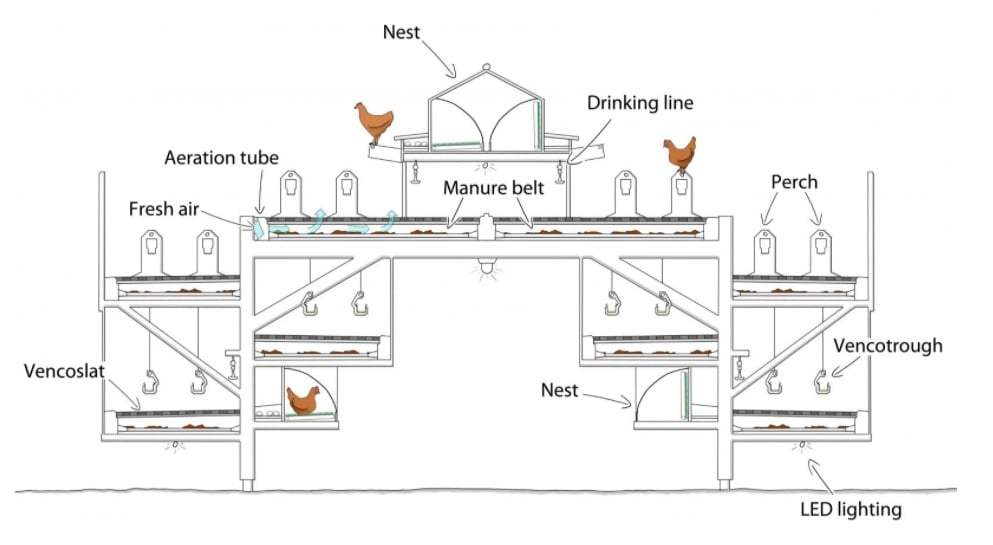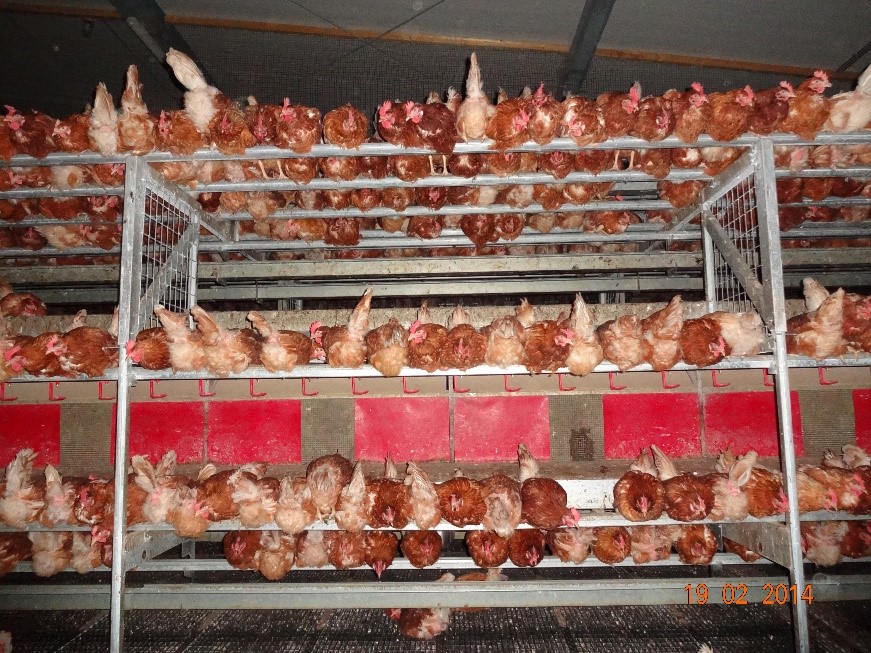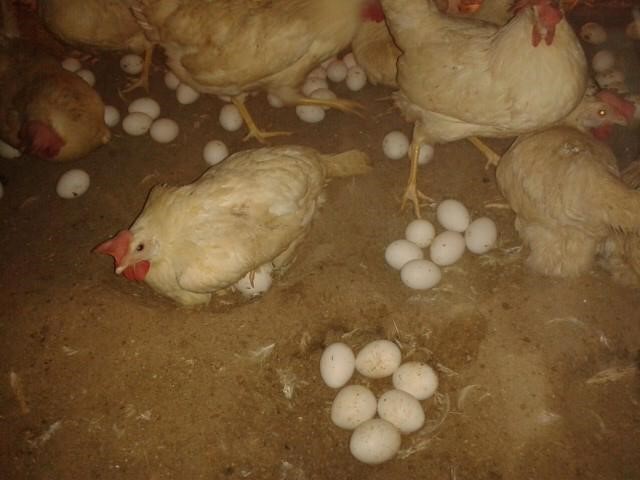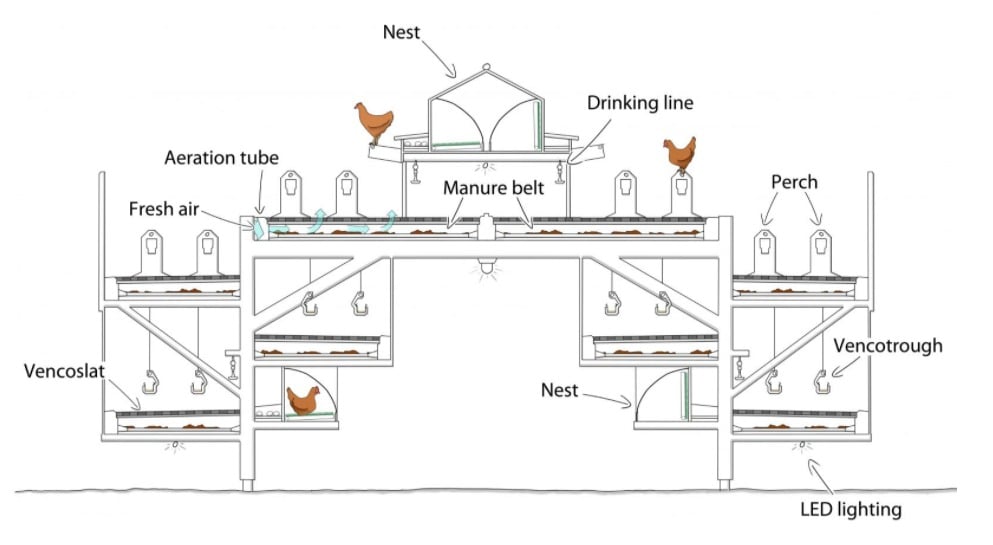The final aspect to achieve good results in an aviary after a good rearing and a correct lay-out is the management of the birds. A few stages can be determined in this: it starts with the preparation for the arrival of the birds. Afterwards, there are a few important points of attention during the period before the first egg is laid as well as after this moment, when the hens start to produce more and more eggs.
This is chapter 4 of our 'Cage Free' booklet.
Arrival of the birds
When you expect a new flock of hens in your aviary, it is important that maintenance or installation have finished completely. Technical issues have to be solved before birds are in the house. Of course sometimes there is no choice, but especially in the first weeks it is important that the birds get comfortable in the house and new housing system. The first weeks they need time for exploring, so when the first egg is laid, they find their way to feed, water and the nests. Also make sure all the equipment (feed, water, manure belts, egg belts, nests, ventilation, lights) is working well, since this is essential for housing the hens in optimal conditions. It also makes sure that you can completely focus on your hens the first weeks, in stead of repairing or adjusting your equipment.
To make sure the birds will be healthy and producing well, there are several aspects to keep in mind. First, the house must be clean. Cleaning and disinfection of poultry houses is essential to manage farm hygiene. This prevents diseases from transferring from one flock to the next. Research shows that the cleanliness depends on the cleaning or disinfection products used and the temperature at which these products are used (Maertens et al., 2018). A clean house also ensures a longer durability of the equipment.
Secondly, the temperature and humidity in the house must be within the comfortable range for the laying hen. This comfort zone differs per hybrid, so ask the breeding company for advice on this. Cold stress causes an increase in feed intake, decreased egg production and egg quality (Li et al., 2020). On the other hand, heat stress decreases the feed intake, egg production and egg quality, while also increasing mortality (Lara and Rostagno, 2013). It is thus important to keep the temperature within the optimal range.
Thirdly, the schedule for the lighting and feed times should be programmed correctly in the computer upfront. Vencomatic Group always advises to visit the birds during rearing, to have an idea how the flock is developing and to make sure you know how the feeding and light schedule during rearing is. If these schedules are similar between the rearing and laying farm, then this decreases stress during this transition. The first evening it is probably easier to dim the lights manually, because the hens are tired and stressed from transport and their new environment.
Lastly, if you want to add some wood shavings on the floor of the scratching area, make sure you put a maximum of 1 cm of wood shavings. A thick layer of wood shavings is attractive for egg laying, which can lead to many floor eggs (Appleby et al., 1986).
Period until first egg
When the hens arrive, it is important to divide them equally through the system on different levels and compartments. The nests must be closed and stay closed until the first egg is found. This ensures that the hens do not use the nests for sleeping to keep them clean, so that the hens are attracted to the nests when they start to lay eggs.
From the first day of arrival, it is important that hens sleep in the system. As we have discussed in part two of this series on 'successful change from cage to aviary', sleeping in the system should come naturally to the birds. Sleeping on high structures is a natural behaviour of chickens, because in nature chicken sleep on the highest branch in a tree to be safe for predators (Collias and Collias, 1967). To help the chickens in this natural behaviour, Vencomatic Group shaped their aviaries as trees as shown in Figure 1. During the first week make sure that all hens are in the system when the lights are off. There are always a few hens that you need to help. So pick them up and place them in the system.
 Figure 1: RED-L aviary system of Vencomatic Group
Figure 1: RED-L aviary system of Vencomatic Group
In nature when the sun goes down, chickens start to look for a place to sleep. We can mimic the sunset in the aviary house by dimming the lights. When you don’t dim correctly, chickens start to drum towards a corner, because they want a sheltered environment to sleep. When it becomes too dark suddenly, hens don’t move anymore and sleep in the litter. The correct way to dim the lights is to start with the lowest and outer lights. This makes the surroundings dark and the hens go to the light in the system. Give them enough time to find a perch place for all hens. Finally, you dim the lights in and above the system gradually. After one or two weeks all birds sleep in the system, this will help you in preventing floor eggs.
 Figure 2: Layers in the evening in a Vencomatic Group aviary
Figure 2: Layers in the evening in a Vencomatic Group aviary
First egg to peak production
When you find the first egg, the nests can be opened. Open the nest at the same time that the lights switch on in the house in the morning. It is not advisable to do this earlier, because then the birds will sleep in the nest and make it dirty. When hens wake up in the morning they start eating and drinking and then lay their egg. Most eggs are laid during 1-5 hours after the lights turn on (Lillpers, 1991), although older birds tend to lay a bit later than young birds (Tůmova and Gous, 2012).
During this egg laying moment, it is important not to disturb the birds. So do not feed the birds during that period for example, but also do not run the egg or manure belts at that moment. When you enter the house during this period, only walk in the scratching area. In the afternoon, when the eggs are laid and the birds are in the scratching area, the system can be checked.
In the period when the egg production starts, it is important that you collect floor and system eggs a few times a day. Hens have the habit to lay the eggs close to each other, so if one hen lays her egg on the floor, other hens will also do so. When hens have found their place to lay their egg, they will come back every time. This phenomenon is called location conservatism (Appleby et al., 1984; Riber and Nielsen, 2013) and is probably a remnant of wanting to lay a clutch of eggs to brood on (Riber, 2010). So removing floor eggs during the first weeks is crucial. If you put some extra effort in this, you have the profit the rest of the production period.
 Figure 3: Floor eggs in scratching area
Figure 3: Floor eggs in scratching area
Production period
During the rest of the production period, it is important that you analyse the production results and bird behaviour, so you can respond quickly when problems occur. A sudden drop in egg production, egg weight or water intake can be a sign of disease or stress. The earlier this deviation is noticed, the quicker you can take action. A fast response limits the losses in terms of production or birds, because these problems tend to get bigger with time. Sudden changes in number of eggs, feed or water intake could also indicate problems with the equipment, so make sure you check this regularly.
To avoid an increase in floor eggs towards the end of the production period, make sure that the litter height in the scratching area does not become too high. It is advised to remove litter to keep the height on maximum 2 cm.
It is important that the feeding troughs become empty once a day, to avoid selective eating. For a well-rounded diet, the hens need to eat particles of all sizes. The larger feed particles are usually the grinded grains or corn, while the smaller feed particles usually contain the vitamins, amino acids, phosphorus and the essential trace minerals (Leentfaar, 2020). These smaller particles are essential for egg production and egg shell quality. Laying hens are selective eaters, which means that they prefer to eat the larger particles and only eat the smaller particles when nothing else is left (Amerah et al., 2007). So forcing the laying hens to eat these smaller particles by not filling the feeding troughs again until they are empty is necessary. Emptying the feeding trough will also prevent accumulation of fine feed particles.
If you take all this in mind, you can achieve very good results with your aviary system and you will be amazed how active and exploring hens are. But also know that with animals, you never have a dull moment and they can surprise you. If this happens and you do not know how to react to it or solve it, do not hesitate and contact your poultry specialists.
With thanks to Anne v.d. Oever for editing.












.png?width=160&height=132&name=Egg%20packers%20-%20Vencomatic%20Group%20(2).png)
.png?width=160&height=132&name=Meggsius%20Select%20-%20Vencomatic%20Group%20(2).png)













